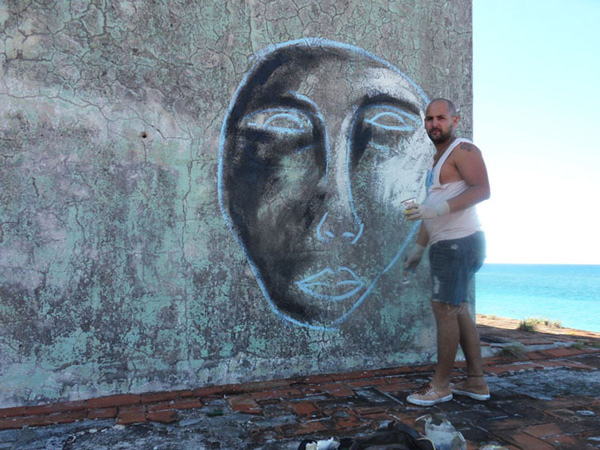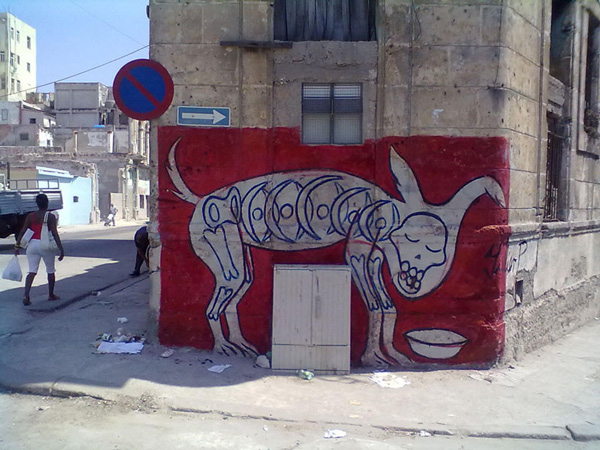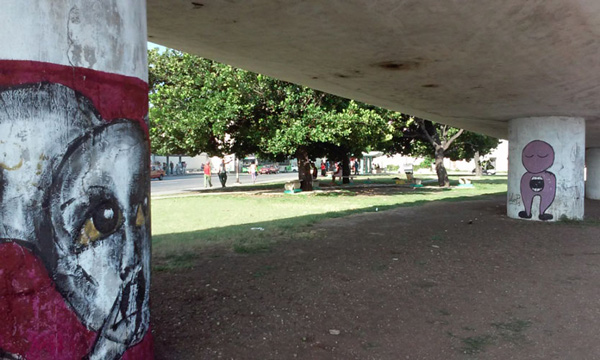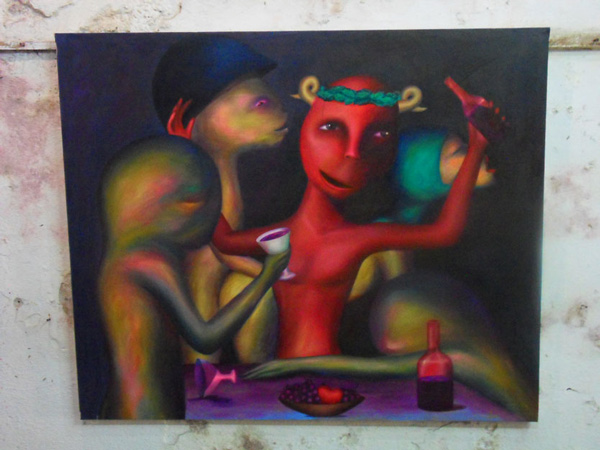Interview with Cuban Graffiti Artist Yulier P.15

By Yanelys Nuñez Leyva
HAVANA TIMES — Known by the humorous monicker of Yulier P.15, this artist makes an effort to greet us at every corner of the city with one of his doodles. The obscure beings he paints occupy a space between parody, mockery, social critique and power mechanisms. They cover large sections of walls, populating every nook and cranny, intrusively taking over the urban landscape.
Our conversation with this 25-year-old artist aims to offer us some clues as to the nature of the inanimate fauna he paints and their message.

HT: What led you to become a graffiti artist?
Yulier Rodríguez: When I started two years ago, graffiti was a means of taking paintings beyond the easel. I felt the need to reach a larger number of people, to distance myself from the world of art and connect with the public. The “white cube” of art galleries had and still has very limited dimensions and the process of submitting projects to these galleries (since I am not an arts graduate) was very complicated. So, everything was pointing in the direction of the street.
HT: So, this graffiti art stems from your painting? How did you discover and enter the visual arts world?
YR: We all paint as children, but what sets a painter apart from others is a kind of obsessiveness or a personality disorder. I think I developed both. I was born in Florida, a municipality in the province of Camaguey. That’s where I started going to my first drawing workshops, at the cultural center there. I then started studying to become an art instructor, but I did this only for a short while, because the conditions were awful and the school wasn’t satisfying my artistic needs. In Havana, I tried to enroll at the San Alejandro Arts Academy but didn’t get in, so I had to find another way.

HT: You share a studio at a privileged location on Prado St. in Old Havana. How did you manage this?
YR: In 2005, the Combatants Association launched a community project for self-taught artists and the general public. Through this project and in that space, they planned on teaching ceramics, theater, drawing and other disciplines. At first, it worked, but, later, a lack of resources led to less and less workshops and the closure of some. The lest costly workshops, like the drawing classes, are still going. Several artists work here and, like me, can exhibit their paintings to anyone interested.
HT: Getting back to graffiti art, I would like to know your process and how you select a location.
YR: I painted my first graffiti works alone. They were very shy pieces, but, soon after that, I started heading out with another graffiti artist with more experience, Yairan. Working with him made me more daring and self-confident.
I try to pick highly frequented places in the city. I try not to paint over the walls of homes or institutions. I go to ruins or the dirtier walls. I like to make these beautiful, give them a kind of face-lift.

HT: If one walks around Vedado, Old Havana, Centro Habana, Cerro, Guanabo or Playa, the places where most of your work can be found, one notices a certain evolution to your pieces. You started painting austere pieces but, for some time now, your work has moved towards mural painting, where the coexistence of several stories and a profusion of color mark a new rhythm. What’s the reason behind this?
YR: It’s been a spontaneous process stemming from my profound interest in beauty. Every day, the work I do out on the street affords me new experiences which become part of the many stories I need to tell. Death, power, the city’s decadence, these are some recurrent motifs in my work, for they are constants in the reality I see around me.
HT: How has the public reacted to your work? Have you had any trouble with the police?
YR: People like it, and I think they do because of the city’s lack of color. There’s so little art out on the street that one cannot help but find this appealing. The police have not been violent. They let me work without any problems, because my paintings are rather ambiguous and can prove confusing.

HT: Do you not feel that you’re running out of walls, that your amorphous figures have covered practically all of the city’s central areas?
YR: Yes, I’m running out of walls, which is why I’m considering painting on trees. We’ll see how that works out.
HT: Do you have any frustrations? What are your future plans?
Yes, the lack of materials frustrates me. Because of this, I can’t do everything I want to, but, I try to get by. As for plans, I would like to be able to continue doing graffiti art and become more visible within the art world. For the time being, though I face every kind of limitation, I continue to work.







I came to Havana just to see your work. We could not stay as long as we wanted to due to the Hurricane but, I did get to see your work in Prado – AMAZING!!!
love your work…. hope you can continue finding locations